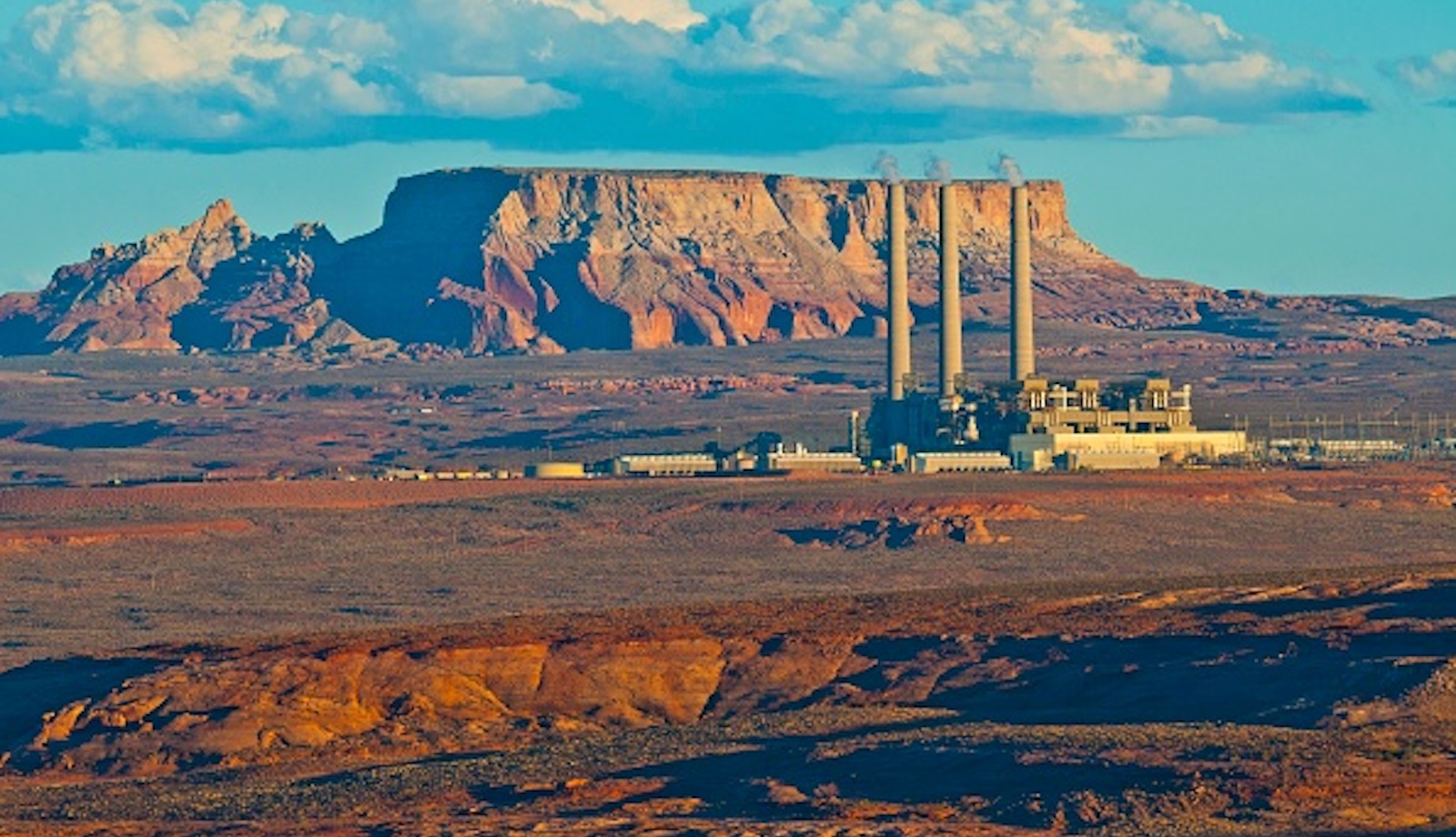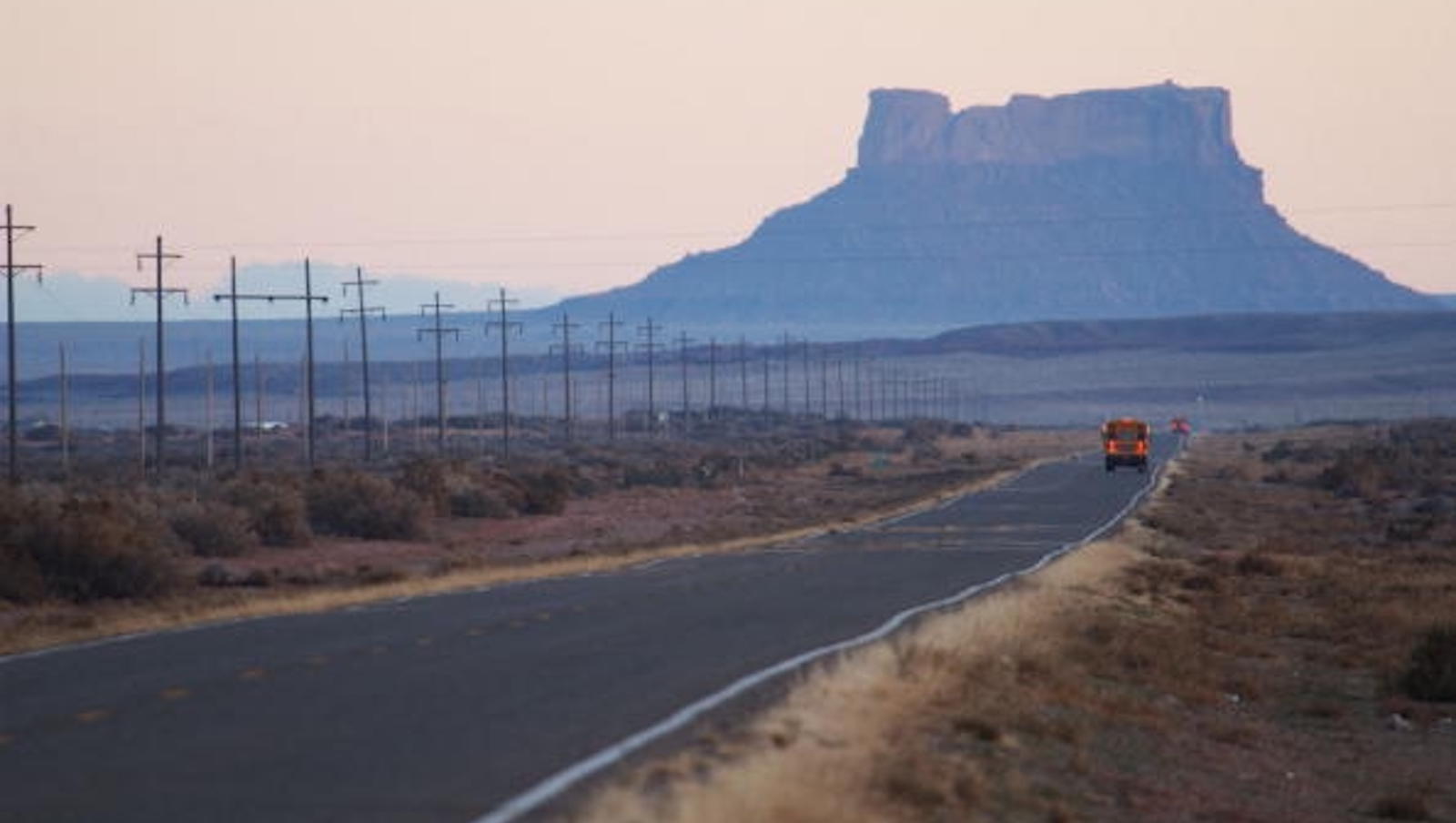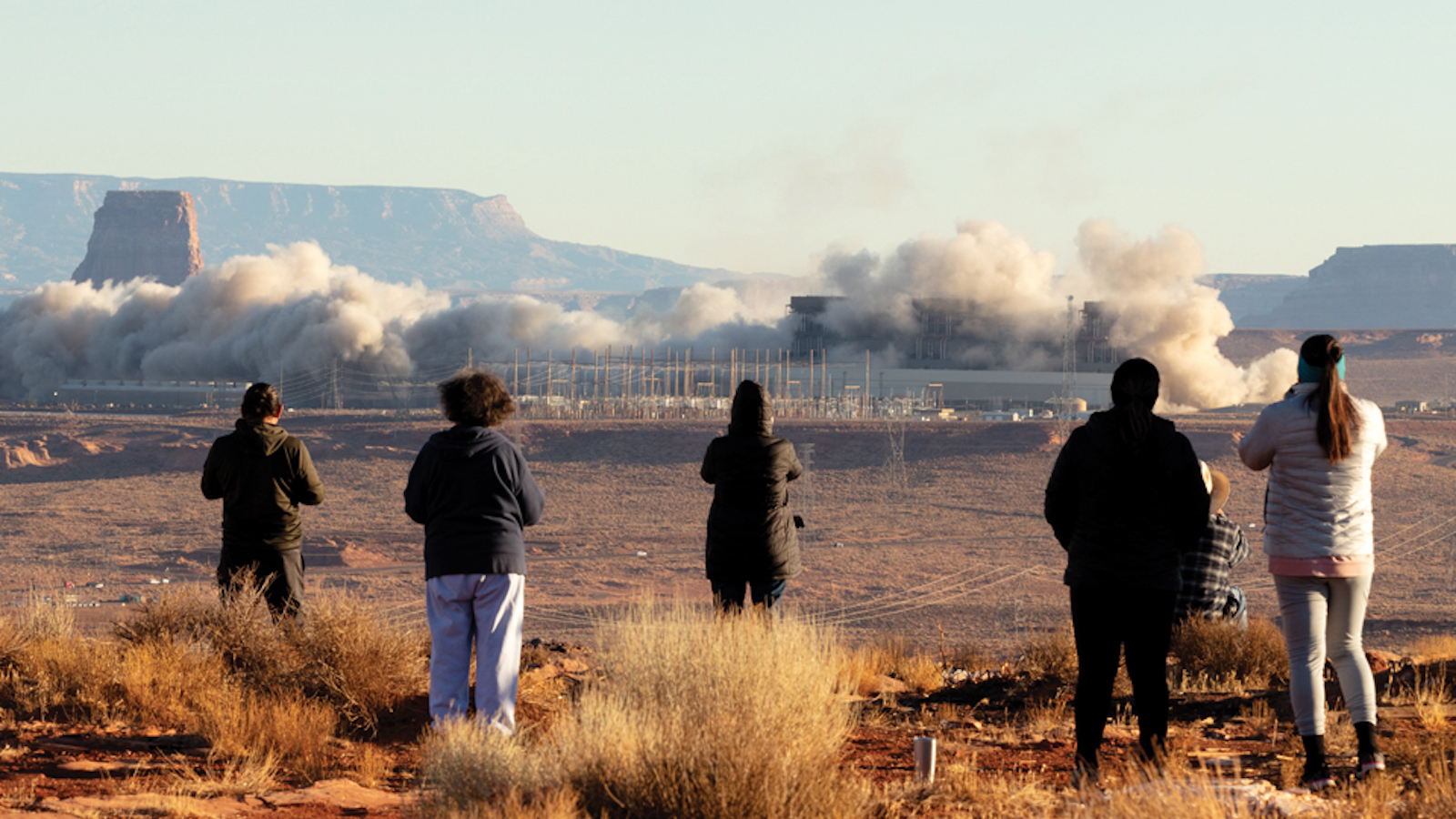This story was originally published by High Country News and is reproduced here as part of the Climate Desk collaboration.
On a chilly December morning in northern Arizona, near the town of Page, Nicole Horseherder stood beside a barbed-wire fence, waiting for the smokestacks of the Navajo Generating Station to fall. The coal-fired power plant, just a mile away, towered against the backdrop of the Glen Canyon National Recreation Area and a cloudless blue sky.
As they waited, Horseherder, a Diné (Navajo) environmental activist, and her husband, Marshall Johnson, spoke into a phone camera trained on the power plant. They were livestreaming the demolition on Facebook. Horseherder’s hands were nestled in the pockets of her long tan wool jacket, its tassels swaying at her ankles. She and Johnson switched between English and Navajo as they spoke to the tens of thousands of people who had tuned in to watch.
The Navajo Generating Station, which opened in 1974 and operated for decades before shuttering in 2019, was the largest coal-fired power plant in the Western United States. It supplied electricity to millions of customers in Arizona, California, and Nevada, using coal from Black Mesa, where Horseherder lives. As she spoke, she acknowledged the economic benefits the plant had brought to the region. “But it has also had devastating impacts to the environment and to some of our most valuable elements of life, such as water,” she said, leaning into the microphone.
The towers shifted and slowly, almost gracefully, began to tilt. The first smokestack began to crumble. Explosives crackled, and Horseherder could feel the earth move through the soles of her boots. And then, one after another, they hit the ground with a thundering boom, leaving a cloud of gray dust in their wake. The demolition was the culmination of years of work: Horseherder has been fighting the ravages of the coal industry for nearly two decades. In her lifetime, thousands of acres of Black Mesa were destroyed for strip-mining, while coal mining depleted the area’s only source of drinking water. Coal miners got sick, and many residents still suffer from asthma, including Horseherder’s mother and two of her daughters.
Now she’s charting a new path forward for the Diné people as the coal economy fades — a complicated quest, since coal has long been an integral part of life on the nation. The industry brought high-paying jobs that sustained families for generations. Many former plant workers were there to watch the demolition that morning. “For the older folks like my dad, that is where they worked,” Irvin Frank Jr., the son of a former steam-pump mechanic at the plant, told me. “That’s how they supported their family over time.”
Over the years, Horseherder has attended public hearings and testified in front of lawmakers, from the reservation to Washington, D.C., advocating for an end to extractive energy economies. She’s often been the lone voice in the room — confronting not only the coal companies and private interests, but also her own neighbors and tribal government. Now that the Navajo Generating Station has closed and other power plants in the region are soon to follow, her vision of a more sustainable energy economy — one powered by wind and solar — is coming more clearly into view. “No matter how frustrated I get, sometimes with the way tribal government works or with how hard it is sometimes to educate people and the community — still, it’s the right thing to do,” Horseherder told me. “And it’s a worthwhile thing to do.”
Though some states like New Mexico and Colorado have recently passed laws that together provide millions of dollars for workforce training and economic support for coal-dependent communities, other states, including Arizona and Nevada, have not. Horseherder is demanding support directly from utilities and industry. It’s a moral imperative, she says. “We’re trying to compel them to provide some kind of transition support for the Navajo Nation instead of just walking away and leaving — leaving the NGS plant and leaving the communities behind,” Horseherder said.
The demolition of the Navajo Generating Station marks the decline of coal in the West. And, if Horseherder is successful in her work, it will also symbolize the beginning of what she calls “a just transition”: a new, more equitable relationship with the energy economy — “one in which there is mutual benefit between the Navajo Nation and its partners,” Horseherder said.

Lake Powell and the Navajo Generating Station from Wahweap Overlook. Education Images / Universal Images Group via Getty Images
Black Mes, a plateau that rises thousands of feet above the Painted Desert, has been home to Horseherder’s people for centuries. Her parents, like the generations that came before, were nomadic sheepherders. On breaks from school during her childhood, Horseherder would wake while it was still dark to lead her family’s sheep to water. She remembers digging in the dry, sandy arroyo for a seep, waiting for water to well up for the sheep to drink. When she returned home a decade later, she found that the land had changed. “I discovered that the seeps had vanished,” she wrote in High Country News in 2013. “The springs at all of the camps from my childhood were drying up.”
Beginning in the late 1960s, the water that Horseherder’s family depended on was diverted to transport coal through a slurry line, 273 miles from a mine on Black Mesa to the Mohave Generating Station in Laughlin, Nevada. At the time, Peabody Energy, the coal-mining company that owned the operation, pumped nearly 3.3 million gallons of water a day out of the Navajo Aquifer, known as the N-aquifer. According to the Natural Resources Defense Council, or NRDC, an environmental nonprofit, Peabody’s pumping depressurized the aquifer, lowering the water table and causing the springs to dry up. Peabody disputes this. In an email to HCN, a company spokesperson stated that the aquifer “is healthy and robust,” something that is “well documented through decades of public and private study.” However, according to the U.S. Geological Survey, some of the wells on the mesa had been in decline for decades. They only stabilized in 2010, a change that one environmental researcher linked to the closure of Peabody’s slurry operation.
The aquifer was Black Mesa’s only source of drinking water in a region that, in some years, gets just six inches of rain. Horseherder and others who lived on the mesa, including members of the Hopi Tribe, whose land lies entirely within the Navajo Nation, didn’t want their precious water carried away to burn coal.
For decades, U.S. mining laws favored corporations and cleared the way for industry to exploit tribal lands under the guise of tribal consultation. Oil prospectors negotiated with a Navajo tribal governing body, which was formed in 1923 by the Department of Interior for the express purpose of energy development on Indigenous land. Too often it was a lopsided relationship, where most of the benefits of ownership flowed off the reservation. On Black Mesa in the 1960s, for example, a Utah lawyer named John Boyden formed an illegitimate council that did not have majority support from the Hopi Tribe. Through this “puppet council,” he negotiated on behalf of the tribe and sold mineral and water leases to Peabody at exorbitantly low rates: $1.67 per acre-foot of water at a time when that water was worth far more than that. According to legal files unearthed by a University of Colorado law professor, Boyden was on Peabody’s payroll at the same time he was working for the Hopi.
Many residents of the Navajo Nation still lack electricity in their homes, but for decades their coal made the lights on the Las Vegas Strip visible from space. While the tribes’ water was depleted to slurry coal, the energy their land produced powered the Central Arizona Project, an extensive canal system, which used the electricity to move water from the Colorado River down to Phoenix and Tucson. Development was booming outside the reservation, but families like the Horseherders hauled water from community wells at chapter houses miles away to care for their homes and animals.
In the 1990s, Vernon Masayesva, a former Hopi tribal chairman and a vocal critic of Peabody’s aquifer use, began hosting talks about coal’s impact on local water. He eventually formed a nonprofit called the Black Mesa Trust. It was during one of these meetings that Horseherder pieced together what had happened to the springs of her childhood. She had recently moved back to Black Mesa, after completing her master’s in linguistics from the University of British Columbia. At a meeting about how to drum up awareness of the water situation, a former tribal leader told her, “Somebody needs to do this work, and I think that person has to be you.” Horseherder didn’t hesitate.
She first consulted with elders to figure out: “OK, how do we do this? How do we start this?” Later that year, she and Marshall Johnson, her husband, founded their own organization — Tó Nizhóní Ání, which means “sacred water speaks” — to halt the use of the N-aquifer for the Black Mesa coal mine. For Horseherder, it also came down to protecting her children and future generations on Black Mesa. “I know outside people just have a hard time understanding that it’s home. There are just so many generations of your family that have existed there and have been living there,” she told me. “Why would you leave to go do something else when the blueprint for a good life is right there?”
When Horseherder began organizing in 2001, some of the largest strip-mining operations in the United States were on Black Mesa. Horseherder and Masayesva were part of a growing resistance, but they were not yet representative of a larger tribal opposition. After attending a Navajo tribal government meeting, Horseherder realized that Black Mesa’s concerns weren’t registering with tribal officials in Window Rock, where the government offices are located. She set out to change that.
She and her husband, Johnson, devised a strategy: They would visit chapter houses, the local governing bodies on the Navajo Nation, and present their argument. Their community’s only source of drinking water was in jeopardy, and in a region with so little precipitation, they wanted that water to stay in the ground.
In those early days, Horseherder raised their children — at that time, a baby and a tween — while Johnson traveled for his job as an ironworker. They spent mornings tuning into the Navajo-language radio station KTNN, often listening outside the house and in their car, “because you know how we had noisy kids back then,” Horseherder said. As the announcer rattled off the schedule, they would jot down the locations of that week’s chapter-house meetings, which they would sometimes travel many miles to attend. They’d bring poster boards covered with information and make their case directly to the community. If the chapter houses voted to oppose Peabody’s pumping of the aquifer, Horseherder could take those resolutions to the Navajo Tribal Council, hoping that it would do the same.
By March of 2003, she had secured 11 resolutions from 14 of the chapter houses that were directly impacted by the coal mining. (They’d go on to secure dozens; there are 110 chapter houses on the Navajo Nation.) In June of that year, the Navajo Tribal Council voted to approve the resolution, formally making the nation’s position clear: The tribe wanted to cease pumping the N-aquifer for the coal slurry that powered the Mohave Generating Station. Peabody had already begun looking for alternative water sources, but when the Navajo Nation formally voted against the use of the aquifer for the slurry line, that cemented the deal. “The resolution changed everything,” Horseherder told the Los Angeles Times. “It meant that if the mine continued using the Navajo aquifer, it did so directly against the wishes and requests of the Navajo tribe.”
“Thirty years of strip-mining have devastated the land and disrupted the life of many people,” Horseherder wrote in her testimony to a California Public Utility Commission at the time. “As the Chapter Resolutions show, the local people are united in this position. We have to stop the groundwater pumping.”
In 2005, thanks in part to the organizing efforts of the Black Mesa Trust and Tó Nizhóní Ání, the Mohave Generating Station closed. The owners, facing a deadline to install expensive pollution controls, could not prove to the California Public Utility Commission that they would have access to the water and coal they would need to keep the plant running. For Horseherder, it was a major win. “It motivated us to keep working for the things that we knew to be true,” she told me. “And that is that (this is) our homeland. And there’s no one else that’s going to protect it — except us.”
Over the years, Horseherder and other Black Mesa residents mounted opposition against numerous proposals that attempted to expand or prolong the life of coal mining on Black Mesa — a second mine, the Kayenta Mine, was still operational, carrying coal to NGS by train. She conducted her own community health surveys, showing the impact of the air pollution on asthma rates near the mines, and she often brought residents from Black Mesa to speak in front of the tribal council. She frequently found herself in opposition to tribal government officials who wanted to keep the mines and power plants open. At a coffee shop this fall, Horseherder told me that sometimes she felt the tribal government prioritized corporations over the people. Raising her voice, she said: “(They) sold the water right out from under us to some company that doesn’t give a shit about us. Once (Peabody is) done mining, they’re going to leave, and they don’t care.”
With NGS shuttered, Horseherder is focusing on clean energy for the Navajo Nation by building support for renewable energy projects. Her organization and other grassroots groups, including the Black Mesa Water Coalition and Diné CARE, have pushed the Navajo Nation to develop a more progressive energy policy in recent years. “They’ve succeeded in making the conversation about transition,” said Andrew Curley, a Diné scholar and assistant professor at the University of Arizona who studies the relationship between coal and the Navajo Nation. “There was even reluctance about that initially. There was a perspective that coal doesn’t need to transition.”
That transition has been painful. The Navajo Generating Station and Peabody paid approximately $40 million in the 2019 fiscal year to the Navajo Nation and millions more to the Hopi. (In 2016, money from the industry accounted for nearly 80% of the tribe’s budget.) These royalties and leasing income funded essential government services like education and health care. “Everybody wants to talk in the language of economics,” Curley said. But it’s more than that; people forge identities around coal. “The dynamics that are often underappreciated are the social (and) political dynamics.”
For many families, it was a tragedy to see coal jobs disappear. Last August, Peabody laid off its workers, even though many could have transitioned to reclamation work — jobs that, according to the Institute for Energy Economics and Financial Analysis, would have kept approximately 200 people employed for at least two years at the Kayenta Mine. Others were more fortunate; the Salt River Project, or SRP, the company that operated the Navajo Generating Station, offered to relocate all of its workers from the power plant. The company has re-hired more than 300 people at other, often far-away, facilities.

School buses carry children across the vast Navajo Nation south of Rock Point on the Navajo Indian Reserve. David McNew / Getty Images
As Horseherder draws up the blueprints for a future where the relationship between energy economies and local communities is more equitable from the start, she’s also pushing to make companies like SRP and Peabody pay. So far, she’s helped secure millions for her community. NGS owners were already paying $110 million to the Navajo Nation over the next 35 years as part of an extension lease and now SRP is looking to buy up to 200 megawatts of solar sited on the Nation. The utility company, Arizona Public Service, has pledged $144 million for transition assistance, economic development, and electrification for the Navajo Nation, Hopi Tribe, and the communities near the Cholla Power Plant in Joseph City. If approved by the Arizona Corporation Commission, the state public utilities commission, it will be the largest amount pledged for an equitable transition by a utility company in the United States.
So far, Peabody has proven the most difficult to deal with by far. The company has submitted a request to the Office of Surface Mining, a federal regulatory agency, to delay much of the reclamation work, which involves returning the open coal pits to workable land, until 2022 at the earliest. The company doesn’t have the best track record. In 2015, nearly a decade after it closed the Black Mesa Mine, the Bureau of Indian Affairs called its reclamation work inadequate, stating that some of the land had taken on “moonscape surface features” due to poor topsoiling and backfilling. Horseherder also fears what could happen to reclamation if the coal-mining company goes into bankruptcy — a likely possibility, since Peabody announced in November that it would have trouble meeting financial obligations. For more than a year now, rolling mounds of coal have sat at the Kayenta Mine in open pits spanning thousands of acres across Black Mesa.
Over the years, the company has chosen not to work with organizers like Horseherder. “They’ll never reach out and say, ‘You know, we hear your concerns. Can we come to some kind of reasonable agreement?’ ” she told me over the phone this fall. Horseherder, who maintains a calm and measured manner in all conversations, seemed to be holding back tears. “They won’t even suggest dialogue.”
Peabody still hasn’t filed a significant permit revision, as is required by law after the mine’s closure. Horseherder has been urging the tribal government to demand this revision, because it would trigger a full environmental impact statement, opening reclamation to public comment and bringing transparency to the process. “This really is the last opportunity for the tribes to have a say in what reclamation looks like,” said Eric Frankowski, the executive director of the Western Clean Energy Campaign, which works with Horseherder. It’s also the final chance to review the damages to the N-aquifer and fight for reclamation of the groundwater. Frankowski said, “If the permit is renewed and rubber-stamped as is, it lasts for another five years.” Peabody maintains that it will resume reclamation work once pandemic-related restrictions are lifted and that it remains “committed to restoring the land as a vital part of the mining process.”
About two hours from Horseherder’s home on Black Mesa, just outside the town of Kayenta, a new future is beginning to take shape. There, the tribe’s first solar facility supplies energy to 36,000 homes on the Navajo Nation. The Kayenta Solar Plant was built in 2016. From the road, the solar panels are arranged in rows like a vineyard, blending in with the sandstone mesa behind them. The project is relatively small; it provides approximately 55 megawatts of solar energy, compared to the 2,200 megawatts-capacity produced by the Navajo Generating Station. Still, it’s one example of a growing effort by the tribal government to bring renewables to the nation. Navajo President Jonathan Nez has been increasingly vocal about steering the nation toward clean energy. “For the many who have called upon our Nation’s leaders to transition away from our overdependence on fossil fuels,” Nez wrote in 2019, in what’s now known as the Sunrise Proclamation. “The Navajo Nation will strive for a balanced energy portfolio and will pursue and prioritize clean renewable energy development for the long-term benefit of the Navajo People and our communities.”
Horseherder’s work securing transition assistance and obligations for new energy contracts could help Diné entrepreneurs get the investments and infrastructure they need to be successful in this energy future. Brett Isaac, for example, grew up near Kayenta in an area called Baby Rocks. In 2018, he co-founded a company called Navajo Power. He’s developing a 750-megawatt project, but, unlike the coal companies of the past, he’s working with the community, building out infrastructure that ultimately benefits Navajo. Eighty percent of his company’s profits will go toward community benefits and investment in new projects. Black Mesa resident Wahleah Johns started Native Renewables, a nonprofit. She builds off-grid solar projects and leads workforce training programs, including for some former coal miners. “We see off-grid solar as a solution to making home stronger,” she said. “When a family member can manage their energy load and own their power, that’s part of the self-determination and self-reliance that we are trying to attain, as a nation and as a people.”
Curley, who has studied past energy transitions, is cautiously optimistic but worries about the existing dynamics around extraction and exploitation. “We were part of an energy economy for 50 years. (Coal) transitioned out, and we were left with all of its costs. … How do we prevent that from happening again, regardless of the technologies involved, whether that be solar or wind?” he said. If “we’re selling (energy) to Phoenix and Tucson, and suddenly there’s something else that comes on the horizon and they don’t want our wind anymore (and) they don’t want our solar, who is going to be left to clean up the cost? Again, it’s going to be us to bear the cost of the transition.
“Energy is a dangerous game to get into,” Curley continued. “If you do clean energy in a colonial setting, you’re still in a colonial setting.” Horseherder agrees: A new energy economy must be structured differently than the relationships of the past. That’s the whole point: “We want to make sure that there’s clear guidelines as to how to operate projects on the reservation, especially for outside entities, but also for inside Navajo developers,” she said.
As the December demolition live-streamed over Horseherder’s cell phone, Diné teachers made their students watch the smokestacks fall from afar. As the towers disappeared into a pile of dust, people cheered, and those in cars honked their horns. Others teared up. “A lot of people that were here this morning to watch this demolition are expressing their sadness to see it go,” Horseherder told her audience. “But, in addition, there are a lot of people here who are looking forward to a renewal of the economy and a renewal of a way of life that doesn’t rely on this coal industrial complex.”
The COVID-19 pandemic was still raging, and the Navajo Nation was closed to visitors. Still, hundreds of people gathered to witness the demolition in person. Sam Minkler, a Diné photographer and associate professor at Northern Arizona University, drove up from Flagstaff to document what he called “the end of coal.” For him, it was the beginning of a new chapter — one that could be more sustainable for the people and the planet. He, like Horseherder, thinks renewable energy should come next.
“The sun is very powerful,” he said. “It runs the earth.”



